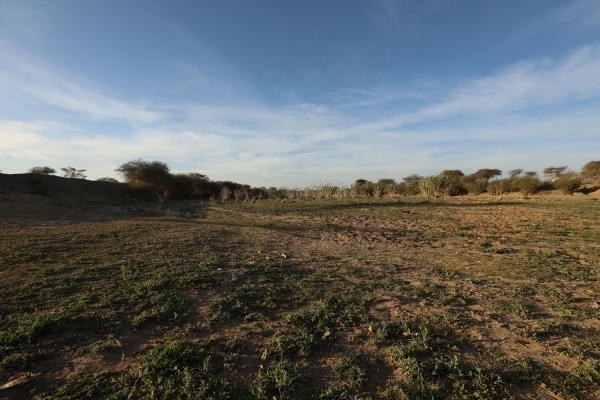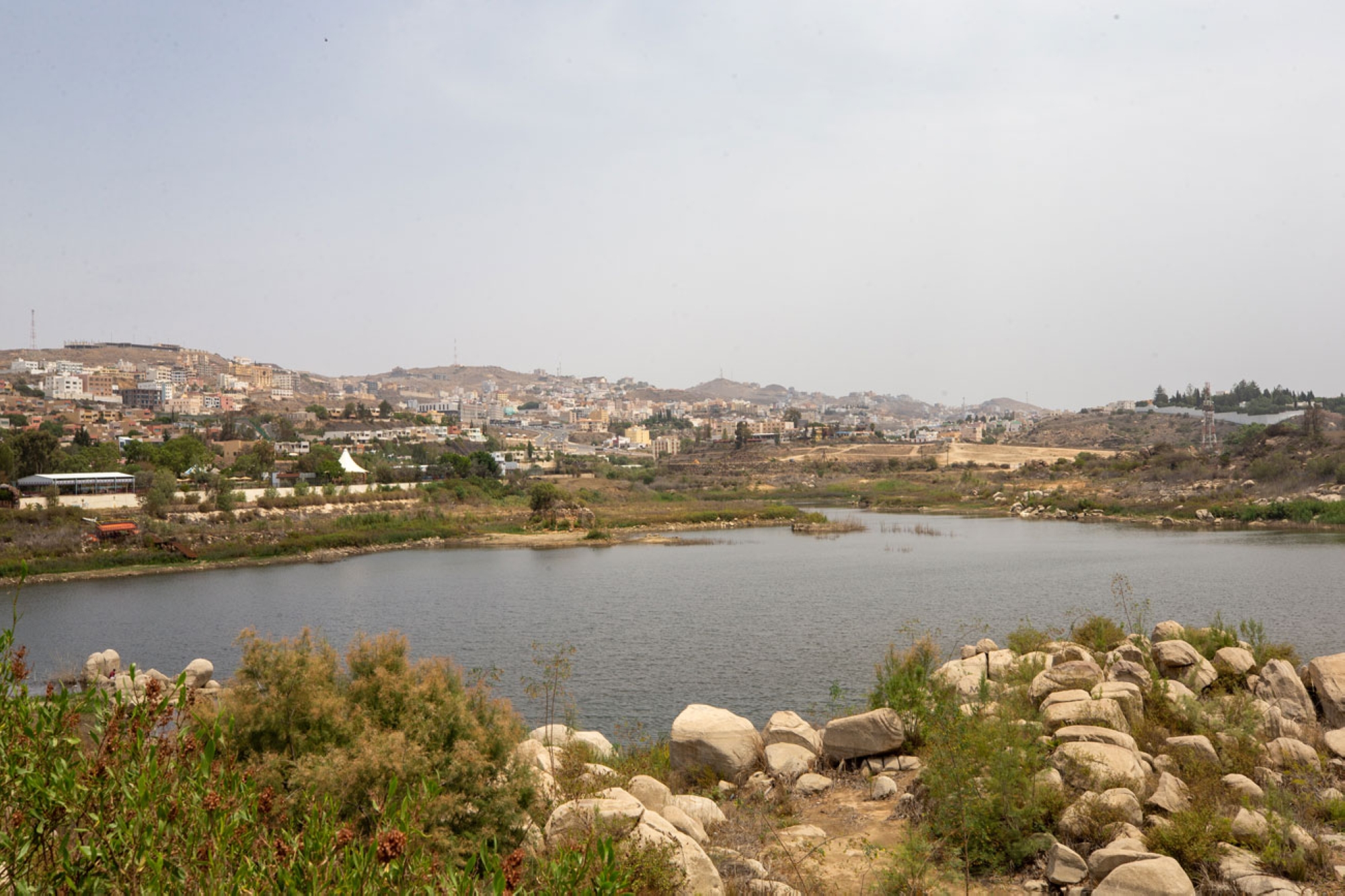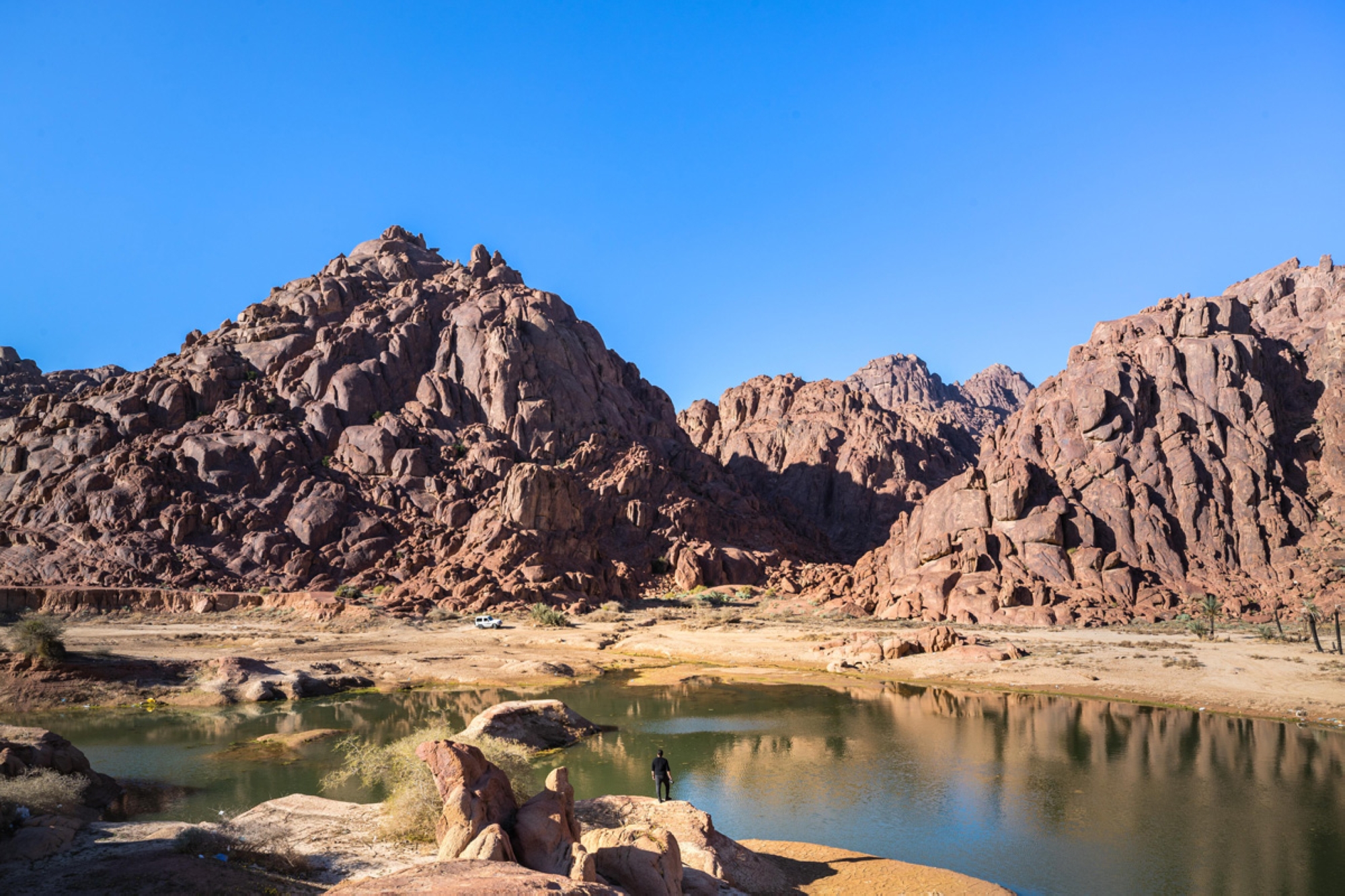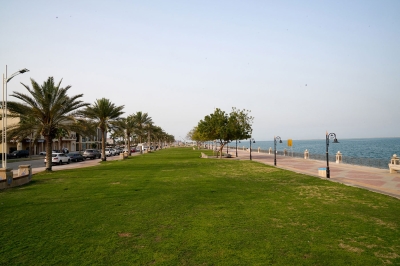
The Climate of the Kingdom of Saudi Arabia is characterized as a semi-arid to arid desert climate with hot days and cold nights, and low annual rainfall except for Aseer Province in the southwestern part of the Kingdom.
The characteristics of Saudi Arabia's climate
The Kingdom's climate is characterized by stability most of the year, due to its location in the hot desert region, between latitudes sixteen and thirty-two° north, with the Tropic of Cancer passing through its middle. While the Kingdom is often thought to be extremely hot, at least four administrative provinces experience winter temperatures as low as minus four degrees, along with snowfall.
The history of studying Saudi Arabia's climate
Interest in studying the Kingdom's climate began in the second half of the twentieth century. Before that, travelers and historians documented their observations about the unusual phenomena they encountered, such as the scarcity or abundance of rain, and the effects of these phenomena on human life.
The climate of the Kingdom is influenced by its geographical location and varies across its regions according to several factors, including the diversity of surface features, vegetation cover, and the distribution of water and land. Temperature, humidity, air masses, and rainfall are prominent elements in shaping its climate.
The climate of Saudi provinces
The climate in the Kingdom varies from one province to another due to its diverse topography, combined with several other factors. Overall, the Kingdom's climate is characterized by being hot in the summer and cold in the winter, with rainfall occurring in the winter.
The highlands, such as the Hejaz and Sarawat mountains in the western and southwestern provinces, moderate the climate of the areas within their boundaries during the summer. These highlands experience intense cold at their highest peaks in winter and receive rainfall throughout the year. This makes Abha City, in Aseer Province in the southwestern part of the Kingdom, the city with the highest rainfall rate in the summer among Saudi cities.

The climate of coastal cities in Saudi Arabia
The coastal cities of the Kingdom are classified as the warmest regions in winter, such as the city of Jeddah in Makkah al-Mukarramah Province and Yanbu Governorate in al-Madinah al-Munawwarah Province. The northern and northwestern cities, like Tabuk, experience the highest levels of cold. The Empty Quarter desert in the eastern part of the Kingdom is the hottest and driest area, with an average annual rainfall of no more than fifty mm.
Winds blow over the Kingdom throughout the year due to its proximity to atmospheric pressure areas, such as the high-pressure area over the Atlantic Ocean and the high and low-pressure areas in Central Asia. This causes the Kingdom to be under the influence of northeasterly winds for most of the year, northwesterly winds in winter, and monsoon winds in summer.
The early part of the winter season in the Kingdom is called 'al-Murabba'iya,' which lasts for forty days, followed by 'al-Shabat,' which continues for twenty-six days, and then comes 'al-Akareb,' lasting for thirty-nine days. The end of 'al-Akareb' season signals the warming of the weather. There is a popular saying to mock those who shed their heavy clothes when they feel warm during some days at the end of 'al-Akareb' season and before the end of the cold waves: "The fool sold his cloak."
Factors influencing Saudi Arabia's climate
Geographical location
The Kingdom is situated in the southwesternmost part of Asia. The climate in the Kingdom is influenced by its geographical location, as it spans over sixteen latitudes. This means that the majority of the Kingdom lies in the hot, dry desert zone. Additionally, it is situated within an area of high tropical pressure in the winter, subjecting it to dry trade winds. In summer, it is under the influence of the hot low pressure over southern Asia, which exposes it to dry continental winds. Therefore, the climate of the Kingdom is characterized by dryness throughout the year and high temperatures, especially in the summer, as it receives direct and nearly direct sunlight, particularly since the tropic of Cancer almost bisects the Kingdom's location.
Land and water distribution
The Kingdom is bordered by two seas on the east and west: the Red Sea and the Arabian Gulf, which contribute to increased humidity in the adjacent areas. The presence of the western highlands and their proximity to the coast limit the maritime influences, as seen in the Jazan Province. The highlands of Yemen and the Empty Quarter desert to the south prevent the influences of the Indian Ocean from reaching the interior, as observed in Najran Province. These combined conditions result in dryness and significant annual and daily temperature variations throughout the Kingdom.
Surface features
The surface features of the Kingdom vary between mountains, plateaus, and plains, creating detailed climatic environments. The highlands influence the temperature of the moisture-laden winds, leading to rainfall, as seen in the Shammar Mountains and the Sarawat highlands. The edges of Tuwayq, which rise to about one thousand m, receive more rainfall than nearby lower areas. The degree of sunlight reflection is also affected by the color of the surface rocks, with darker colors absorbing more radiation. Additionally, the spread of sandy formations affects the surface temperature, contributing to higher temperatures of both the surface and the winds that pass over it.
Vegetation cover
Vegetation influences and is influenced by climatic conditions in several ways. It acts as windbreaks, reducing wind speed, and protects the soil from solar radiation. Generally, plants are more abundant in the southwestern regions of the Kingdom due to the ample rainfall, as seen in al-Bahah Province. In other areas, vegetation is relatively sparse due to the overall arid conditions, which increases the impact of sand and dust storms. The Kingdom's government is working to expand the vegetation cover through various initiatives, most notably the Saudi Green Initiative, which was launched in 2021.
Elements of the climate in Saudi Arabia
Temperature
The Kingdom's climate is generally characterized by high temperatures in the summer due to its location in the tropical hot zone, close to the equator. The sky is clear in most areas, with annual sunshine hours averaging no less than 3,300 hours. The vast sandy areas, which cover a third of the Kingdom, contribute to the rising temperatures, especially in the afternoon, along with the blowing of dry continental winds. Winter sees a relative drop in temperatures.
Overall, the maximum temperatures across the Kingdom range between twenty and thirty degrees Celsius in winter, which lasts from December to February. In spring, from March to May, temperatures range between thirty and forty °C. Summer, from June to August, sees temperatures ranging between thirty-five and forty-five °C. In fall, from September to November, temperatures range between twenty-five and thirty-five °C.
Humidity
Humidity and temperatures rise in the coastal provinces and cities. Moving towards the coasts of the Red Sea in the west and the Arabian Gulf in the east, humidity levels increase. In contrast, in the central provinces, consisting of plateaus and deserts, a continental dry climate prevails, characterized by high temperatures in summer and cold, rainy conditions in winter.
Air masses
In winter, the Kingdom's climate is influenced by the continental polar air mass and the maritime polar air mass formed over the North Atlantic Ocean, which moves south and southeast across the Mediterranean Sea. This leads to rainfall in the northern and western parts of the Kingdom, such as the Tabuk Province and parts of al-Jawf Province.
In summer, the Kingdom's climate is influenced by the continental tropical air mass formed over the Asian and African continents, leading to high temperatures. It is also affected by the maritime tropical air mass formed over the tropical oceans, which moves towards the southwestern part of the Kingdom, causing rainfall in the southern Hejaz Mountains and the Sarawat Mountains.
Rain
Rainfall increases during the winter and spring seasons across all provinces of the Kingdom. The southwestern areas are characterized by summer rainfall, and the city of Abha in Aseer Province is one of the Kingdom's cities with the highest summer rainfall rates.
The rate of rainfall varies from year to year. The parts located in the southwestern highlands, such as an-Namas in Aseer Province and Baljurashi in al-Bahah Province, experience higher amounts of rainfall. These are followed by the northern areas such as Hail, and then the interior regions like Qassim and Riyadh. The desert parts of the Empty Quarter record the lowest annual rainfall rate.

The annual average rainfall in the Kingdom in 2018 reached 127.8 mm, a difference of about forty-one mm from its average in 2010. The Kingdom has been implementing a cloud seeding program since 1990 to increase its rainfall rate by 20 percent and compensate for the consumption of non-renewable groundwater resources.
In April 2023, different provinces in the Kingdom recorded a higher-than-average rainfall level, reaching 31.81 mm. This surpassed the highest average recorded in about forty years, which was 13.13 mm. It also exceeded the highest average in April 2022, which was 9.23 mm.
The number of rainy days amounted to twenty-six days, with the highest daily number of rainfall readings recorded on April 25, totaling 137 readings. The highest rainfall reading was recorded on April 14 at the Shaab Ahmad station located in Aseer Province, registering approximately seventy-nine mm.
Climate monitoring in Saudi Arabia
The beginning of climate study in Saudi Arabia
The study of climate in the Kingdom began in the second half of the twentieth century. Before that, travelers and historians would document unusual weather phenomena, such as the absence of rain, heavy rainfall, and the resulting drought, dryness, or locust plagues that would damage crops.
The first records of information appeared in 1956 through the Meteorological Department (currently the National Center for Meteorology), and saw development in the following years, appearing in a better form in 1966 with approximately twenty measurement stations spread across twenty airports in the Kingdom.
In 1964, the Ministry of Agriculture and Water (currently the Ministry of Environment, Water, and Agriculture) established stations to measure and provide essential hydrological information in thirty-five centers across the Kingdom to understand water resources. Subsequently, more stations for measuring rainfall emerged.
National Center of Meteorology
The National Center for Meteorology is entrusted with the task of providing specialized weather and climate services, as well as all matters related to meteorology, whether at the local, regional, or international level. The approval for the establishment of the National Center for Meteorology was issued on March 26, 2019. Its tasks include enhancing the level of weather forecasting services, providing sufficient and accurate early warnings, and supporting the response to climate change through reliable medium- and long-term climate predictions.
The center also aims to cover a larger geographical range for the meteorological services provided by enhancing monitoring capabilities in various provinces. To achieve this, it relies on modern technical capabilities and collaborates with specialized entities in the field from around the world.
Automated early warning system
The National Center for Meteorology provides a service that allows weather monitoring alerts to reach beneficiaries. Based on the information issued by the center, Civil Defense sends warning text messages about the weather, including a brief description of the condition, whether it is rain, hurricanes, wind, or dust. These messages reach citizens and residents based on the geographical location covered by the weather conditions.
Climate change
Changing weather patterns and average temperatures, known as climate change, are key factors in the global rise in temperatures, leading to noticeable changes in the climate. Human activity is a major factor in these changes. Since the nineteenth century with the industrial revolution, there have been changes in global temperatures, with an increase due to the burning of fossil fuels and human interaction with the environment. The Kingdom is among the countries affected by these factors due to the sensitivity of its ecosystems, the scarcity of renewable water sources, and its heavy reliance on fossil fuel exports. However, it is making efforts both locally and globally to combat this phenomenon, endorsing numerous international treaties supporting the fight against it.
Saudi Arabia's climate efforts
Climate concern within the transformation of the environmental sector
The Saudi government places significant emphasis on climate change, having established a Ministry of Environment and adopted the National Environmental Strategy. In addition, the Environment Fund was established in 2019, and the Environmental Law was issued in 2020. These initiatives aim to protect the environment and achieve the Saudi Vision 2030 for quality of life, considering environmental considerations and balancing protection with economic requirements.
The Kingdom aims to combat climate change by adhering to international standards and agreements. This commitment is reflected in the initiatives: the Saudi Green Initiative and the Middle East Green Initiative, which are among the global initiatives focused on protecting the environment from climate change.
As a country heavily reliant on oil, the Kingdom dedicates efforts to simultaneously preserve the environment and stabilize energy markets for sustainable development. It is developing economic plans to diversify Saudi income sources, achieving mutual benefits that mitigate the impacts of climate change.
In its efforts to combat climate change, the Kingdom is working to reduce desertification and utilize resources through consumption rationalization. The Kingdom also supports environmentally friendly practices such as waste recycling, with sustainable development being a fundamental pillar for the success of its developmental plans. This approach aligns with the Kingdom's energy policy and reinforces its role as a global partner in providing responsible and reliable energy.
Saudi Green Initiative
The Saudi Green Initiative is one of the Kingdom's contributions to combating climate change. It involves collaboration between community members, government entities, and the private sector to protect the environment, thereby expanding efforts to address climate change. The initiative supports Saudi Vision 2030 within the Quality of Life Program and was launched in 2021, giving rise to approximately eighty programs and projects.
The initiative aims to achieve several goals by 2030, including reducing carbon emissions by more than 278 million t annually, planting ten billion trees across the Kingdom, and protecting 30 percent of the terrestrial and marine areas in the Kingdom.
To support the initiative's goals of reducing emissions, the Kingdom is constructing the world's largest green hydrogen production plant in the city of 'Oxagon' in NEOM. The plant is expected to have a production capacity of up to six hundred t by 2026.
Middle East Green Initiative
The Middle East Green Initiative contributes to combating climate change by increasing vegetation cover and is considered one of the largest afforestation programs in the world. The initiative was launched by Crown Prince and Prime Minister His Royal Highness Prince Mohammed Bin Salman Bin Abdulaziz Al Saud in 2021. The capital, Riyadh, hosted the first summit of the initiative, which included the first regional dialogue on climate. The summit received support from leaders of around twenty countries.
The initiative proposes a plan for regional climate action and unifying efforts with participating countries to mitigate the impacts of climate change, address environmental challenges, and improve quality of life and public health. This will be achieved by increasing the percentage of protected areas to over 30 percent of its land, surpassing the current global target of 17 percent for each country. Additionally, the initiative aims to plant fifty billion trees across the Middle East, increase the contribution of renewable energy, undertake activities that protect coastal and marine environments, and increase the percentage of natural reserves.
The Regional Center for Climate Change
The Regional Center for Climate Change was launched in 2023 to support the Kingdom's efforts in meteorology and climate change. It was established to collect climate-related research to study the impact of weather on afforestation initiatives stemming from the Saudi Green Initiative. The center aims to collaborate on developing climate information, and providing plans that contribute locally, regionally, and globally. Additionally, it focuses on studying renewable energy resources and measuring their impact on carbon emissions.
The center contributes to raising community awareness about the impacts of climate change and helps mitigate its effects. It enhances the Kingdom's environmental performance to reduce the consequences of these changes and promotes eco-friendly industries.
Saudi Arabia's participation in combating climate change
The Saudi government plays an active role in combating climate change and participates in numerous initiatives to address and mitigate its impacts both locally and globally. It aims to contribute to reducing global methane emissions by up to 30 percent by 2030 to protect the environment. To achieve this goal, the Kingdom has joined the Global Methane Pledge, which represents a significant step towards reducing greenhouse gas emissions.
The Kingdom has also joined the United Nations 'Sports for Climate Action' initiative in 2022 and participated in the United Nations Climate Change Conference in Glasgow in 2021. Additionally, the Kingdom ratified the Paris Agreement on climate change in 2016.
Related quizzes
Related articles


